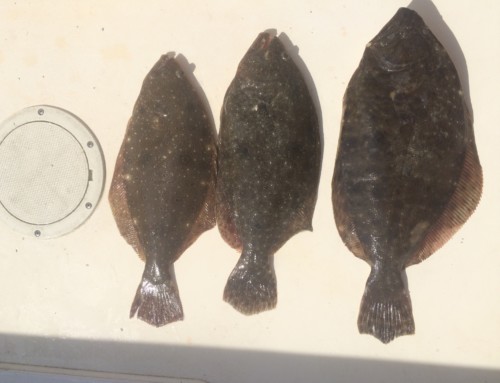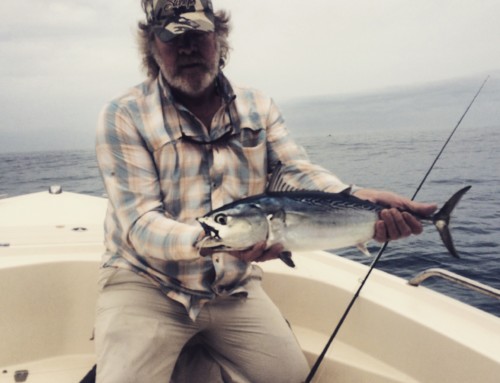Everything you need to know about the Atlantic Bonito…
By Tom Roller
When North Carolina’s spring finally rolls along, local fisherman are usually preoccupied with the Roanoke River stripers and dreaming of a day offshore chasing yellowfin tuna. Many anglers overlook one of North Carolina’s most consistent spring fisheries – the fantastic April run of the hard-fighting and delicious Atlantic Bonito.
Outside of Long Island and Martha’s Vineyard, where they have a cult-like following of loyal anglers, Bonito are often mislabeled and relatively unknown to most saltwater anglers. In North Carolina, Bonito are rarely targeted but are often mistakenly caught by anglers trolling for Spanish in the spring months. As one of the few guides who target Bonito, I begin the spring with specially priced Bonito charters –not only to celebrate the new season but to educate anglers about this little known and first-rate light tackle fish.
The Bonito is often confused with its very similar cousin, the False Albacore (also called Little Tunny). While their appearances are similar, it is the name which causes the most confusion. Most Floridians refer to False Albacore as Bonita (notice with an A), and this colloquial name causes confusion up and down the East Coast, often making for many arguments on internet fishing forums. Don’t let the names fool you, these two fish are very different. When the two fish are compared side by side, their differences are obvious. False Albacore are football shaped with a large dorsal fin, have green squiggly lines covering the area above their lateral line between their dorsal fin and tail, and often bear black spots near their pectoral fin. Bonito, on the other hand, are torpedo shaped and have diagonal “racing stripes†down the entire length of their backs. The most striking difference between these two fish is their mouths. Since False Albacore tend to gulp their prey, they have the small, sandpaper-like teeth common to most tunas. The Bonito’s mouth is arranged just like that of a mackerel and lined with razor-sharp, needle-like teeth designed for slashing and grasping.


Like all tuna, Bonito are short-lived, fast growing and quick to mature. The average fish is between 4 and 6 pounds, with 7-8lb fish fairly common. While North Carolina does not have a category for Bonito, the current IGFA all-tackle record is 18 pounds 4 ounces. While east coast fish rarely exceed ten pounds, some of the IGFA fly line class (tippet) records are within reach. A determined fly-angler would stand a good chance at breaking an IGFA record.
Even if you’re not after a world record, the Bonito are a world-class light tackle fish. Extremely aggressive, Bonito will viciously slash at artificial baits and will come porpoising out of the water to pounce on a zigzagging top-water plug. Once hooked, the Bonito dishes out a battle filled with drag-screaming runs. Typically, after taking the bait, the fish hesitates before learning that’s he been hooked, and it is then that the fish can scream off 50 to 100yds of line in a heartbeat. After a few hard runs, the fish will finally engage in a final tug-of-war, circling under the boat. Because Bonito are a bit smaller than the average False Albacore, anglers can use lighter tackle for a more dynamic fight. For this reason they are particularly kind to the fly angler as casting an 8 weight rod is much more fun than casting a 10 weight.
Bonito are one of the finest eating fish that anglers can pursue off the North Carolina coast. Their meat has the dense, firm texture of tuna steaks but is almost white in color. It’s so good that many people I know prefer it to Yellowfin Tuna! Its flavor is sweet and mild, and it can be cooked using a variety of methods. If raw is your thing, Bonito makes fantastic sashimi, but it’s particularly good when seared like yellowfin and served slightly rare. It’s also good sautéed or grilled with cracked black-pepper and olive oil, or with an acidic marinade (ginger and soy, or citrus). Bonito flesh is some of the most expensive and sought-after sushi in select urban areas. It’s valuable not only for its taste and texture, but because the flesh spoils within three or four days (like Spanish mackerel) and freezes very poorly, even when vacuum sealed. The difficulties of transporting and preserving bonito make it almost impossible to find in the fish markets. Often the only way to enjoy them is if you target them yourself.
There have been few scientific studies done on the Atlantic Bonito. Most of the information we have is common knowledge that has been gathered and shared by anglers. Bonito, like any migrating fish, travel in accordance to water temperature and food supplies. While the Bonito is common over the entire Atlantic Ocean (from South America to Africa and all the way to Norway), they are rarely seen on the eastern seaboard south of the Carolinas. While they are a regular summer by-catch for Gulf Stream fishermen, Bonito are most famous for their forays into inshore waters. They are occasionally caught in South Carolina waters and are most famous for their summer-long runs in Long Island Sound and Martha’s Vineyard, where they can be caught from shore. However, the first stop on their yearly journey is along the southern beaches of North Carolina, particularly from Cape Fear to Atlantic Beach.
In North Carolina, the magic water temperature for Bonito tends to be around 62 degrees. Bonito move to inshore structure in mid-spring, as warmer water begins creeping towards shore. When that warmer water finally hits the inlets, the action takes off. It’s common to see Bonito busting bait from the inlets all the way to the Artificial Reefs and live-bottoms. Like most predatory fish, Bonito prefer structure that holds good concentrations of baitfish.
In the early part of the season, it is common to see some Bonito mixed in with the False Albacore. Once the water temperature warms up past 65, Bonito dominate the scene for two to three weeks or until the water warms over seventy degrees. For another week or so, they can be found traveling in mixed schools with large Spanish mackerel until their numbers dwindle to a few remaining stragglers come mid-May.
When gearing up for Bonito, I like to use my typical trout rods – basic 6-7’ medium to medium-heavy rods coupled with a high-quality 3000 series reel spooled with 8 to 10lb test. For the fly angler, any 7 or 8 weight rod with 250-grain sinking line is the ticket. I keep my selection of lures very simple. I prefer ½ or 1¼ ounce stingsilvers, jig-heads with white Fin-S tails and some Mirrolure Top-Dogs. As for flies, any half-and-half clouser in the 2 to 2/0 size will produce, but my two favorite are the reliable chartreuse and white or pink and white. Since Bonito have such sharp teeth, a leader is necessary. However, like all tuna, Bonito rely on their eyesight to feed and can be very leader shy at times. I typically find twenty pound monofilament adequate, but if the water is particularly clear, light fluorocarbon (12-20lb) is the ticket. I prefer to attach the leader to my main-line using a very small Spro swivel, which helps cut down on line twist from spoons and jigs.
Unlike the often picky albacore, Bonito are very aggressive and will usually hit just about anything that catches their eye. Often, particularly in the early hours, large schools of Bonito can be found crashing bait on the surface. In these circumstances you can toss just about anything at them, but I prefer to use top water-plugs like Top-Dogs. Bonito will attack a plug “walked†across the surface with gusto, often coming completely out of the water to pounce on the bait. When the fish are breaking on the surface, I urge anglers to be courteous towards those around them. Chasing the fish down or trolling directly through the school will not produce strikes—it will only scatter them and drive them from the surface. Your best bet is to position your boat upwind, kill your engine and drift through the fish.
If the fish are not showing themselves, finding the bite can be tricky. Begin by concentrating on an area of structure while watching your sonar for schools of baits. Once you identify them, you begin targeting them at the right depth by deep jigging stingsilvers or casting flies on a sinking fly line. As my good friend Captain Gordon Churchill taught me, it is at these times that fly fishing can be more productive than traditional methods. Using a 250 grain line, you can suspend a fly (any size 2 to 2/0 half and half clouser works well) above the structure and thus keep your bait in the strike zone longer. If the fish are there, you will find them quickly
If you plan on keeping your fish for the grill, it is a good idea to bleed them by slitting their gills and immediately putting them on ice. There is no limit on the Bonito, and anglers are not required to obtain a NMFS permit to target them. Although you can keep as many as you desire, I urge anglers to be modest with their catch – not just for the sake of conservation but because as I mentioned, their flesh spoils quickly and turns mealy when frozen (even if vacuum-sealed).
North Carolina’s spring Bonito run is a dependable way to kick off the new years of fishing. Before the summer crowds and high temperatures, anglers can enjoy remarkable fishing, mild spring weather and miles of open water. North Carolina anglers have the rare privilege of pursuing the hard-fighting Bonito, and it’s early enough in the season for newcomers to try their hand. The run is short, so come catch ‘em before they’re gone…
(c) Copyright Tom Roller and WaterDog Guide Service – this article may not be copied or reproduced without permission.


